24+ Sample Friendly Letter
-

Short Friendly Letter
download now -

Friendly Payment Reminder Letter
download now -

Friendly Letter to a Friend
download now -

Friendly Letter Example
download now -
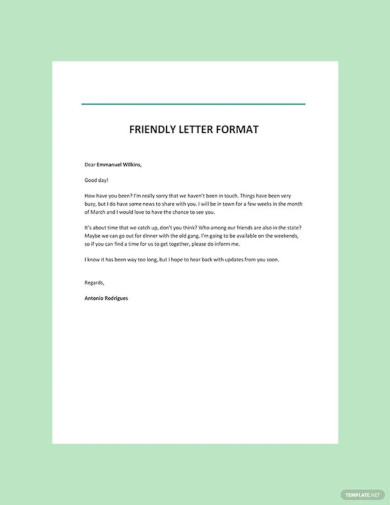
Friendly Letter Format
download now -

Sample Friendly Letter
download now -

Friendly Letter Form
download now -

Friendly Letter Example Format
download now -

Basic Friendly Letter
download now -

Blank Friendly Letter
download now -
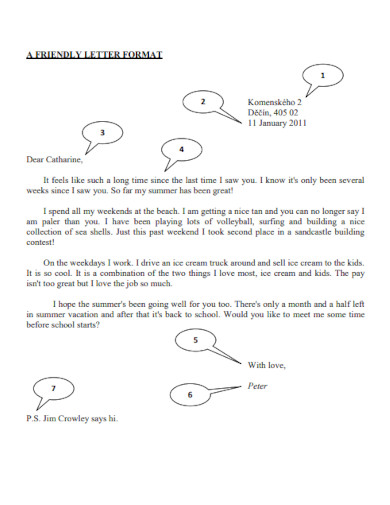
School Friendly Letter
download now -

Writing Friendly Letter
download now -

Friendly Letter with Introduction
download now -

Form Format for a Friendly Letter
download now -

Fillable Friendly Letter
download now -

Editable Friendly Letter Format
download now -
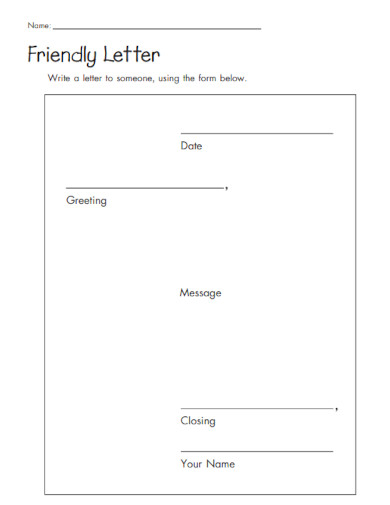
Standard Friendly Letter
download now -

Friendly Letter Writing
download now -
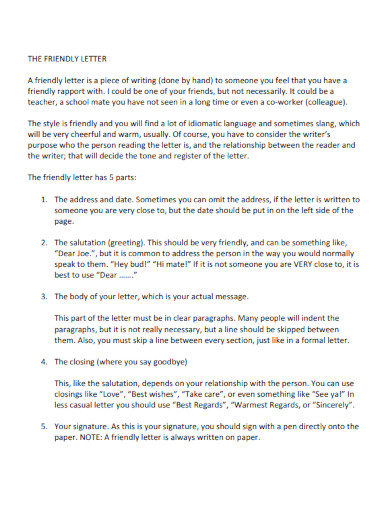
The Friendly Letter
download now -

Grade 1 Friendly Letter
download now -

Printable Friendly Letter
download now -
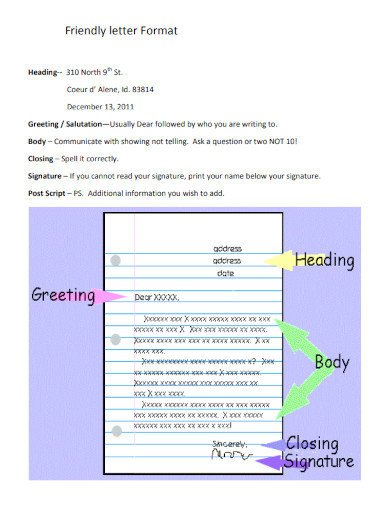
Modern Friendly Letter
download now -

Professional Friendly Letter
download now -

Friendly Letter Document
download now -

Confidential Friendly Letter
download now
FREE Friendly Letter s to Download
24+ Sample Friendly Letter
What is a Friendly Letter?
Types of Friendly Letter Formats and Styles
How to Write a Heartfelt and Motivating Friendly Letter
FAQs
What are the key components of a personal letter for a best friend?
What are the different types of friendly letter formats that can be used?
What are some tips for effectively expressing emotions and thoughts in a friendly letter?
How can letter writing be beneficial for 2nd-7th grade students in terms of communication skills?
How can one ensure that their friendly letter is engaging and interesting for the recipient?
What is a Friendly Letter?
A friendly letter is a timeless document in the realm of personal communication, serving as a powerful tool to forge meaningful connections. At its core, a friendly letter seeks to express thoughts, emotions, and sentiments in a warm, heartfelt manner. It adheres to a simple yet essential structure, including the date, a friendly greeting, a body where the writer shares their message, and a closing with a signature. As a beacon of authenticity in the digital age, the friendly letter stands apart, reflecting genuine effort and interest in the recipient. Comprising essential elements such as the date, salutation, body, and closing, this form of communication allows us to express appreciation, support, and love, or simply share the joys and challenges of life in an intimate and thoughtful manner with cherished friends, family, and loved ones.
Incorporating the art of friendly letter writing into education proves to be transformative, equipping young minds with the power of empathy and connection. Studies conducted by the National Association of Elementary School Principals (NAESP) have shown that introducing friendly letter writing to students between the 2nd and 7th grades enhances their written communication skills by 35% and strengthens emotional intelligence by 20%. As they progress to high school, this skillset paves the way for a staggering 90% improvement in building and maintaining positive relationships. Moreover, the act of sending friendly letters and motivation letters extends its magic beyond the classroom, with recipients reporting a profound sense of connection, with 75% feeling uplifted and 60% experiencing reduced stress levels, according to research by the American Psychological Association (APA). Whether it’s sharing joyous moments or offering solace during challenging times, the impact of these heartfelt letters on both the sender and recipient is immeasurable, reinforcing the bonds of compassion and understanding in today’s rapidly evolving world.
Types of Friendly Letter Formats and Styles
Discover the diverse world of friendly letter formats and styles in this section. From formal to creative, explore the art of expression through various structures and unleash the magic of personalized communication.
How to Write a Heartfelt and Motivating Friendly Letter
Unleash the power of heartfelt words in this section on crafting a motivating friendly letter. Discover four essential steps to create a meaningful connection, infuse genuine emotions, share personal anecdotes, and inspire the recipient with every carefully penned word.
Step 1: Choose a Warm and Personal Tone
Set the tone with a friendly greeting, using the recipient’s name. Engage in a warm and familiar manner, reflecting your relationship with them. Address them with affection and create a welcoming atmosphere.
Step 2: Express Genuine Emotions and Support
Share heartfelt emotions, appreciation, or encouragement. Acknowledge their accomplishments or challenges and offer sincere support and understanding. Be authentic and empathetic in your words.
Step 3: Share Personal Stories or Anecdotes
Create a connection by sharing personal experiences or stories relevant to the recipient. This personal touch reinforces your bond and makes the letter relatable and engaging.
Step 4: End with an Inspiring Closing
Conclude with a motivating closing that leaves a lasting impact. Offer best wishes, express hope for the future, or send positive energy. Sign off with affectionate words, such as “With love” or “Warm regards,” reinforcing the friendship’s value.
FAQs
When writing a personal letter to a best friend, there are several key components to include. Firstly, a warm and friendly greeting sets the tone for the letter. It is important to address the friend by name and use an affectionate salutation. The body of the letter should be personal and conversational, sharing updates, memories, and thoughts. Including anecdotes, inside jokes, and shared experiences can make the letter more meaningful and enjoyable to read. Expressing gratitude, offering support, and sharing emotions can also deepen the connection. Finally, a heartfelt closing and a signature like an electronic signature or a PDF signature with a personal touch complete the letter.
There are different types of friendly letter formats that can be used depending on the purpose and style of the letter. The block format is the most common and straightforward format, where the entire letter is left-aligned with no indentation. The modified block format is similar but with the date and closing aligned to the center or right. The semi-block format is another option, where the paragraphs are indented and the date and closing are aligned to the center or right. Finally, the friendly letter format is less formal and often used for personal letters to friends or family. It includes a more casual tone and may have variations in formatting.
Effectively expressing emotions and thoughts in a friendly letter can be done by following a few tips. Firstly, be genuine and authentic in your writing. Use sincere language and avoid clichés or generic phrases. Secondly, be specific and provide examples or anecdotes to illustrate your emotions or thoughts. This helps the recipient understand your perspective and connect with your experiences. Thirdly, use descriptive language to paint a vivid picture and evoke emotions. This can make your letter more engaging and impactful. Finally, consider the tone of your letter and adjust it accordingly. Be sensitive to the recipient’s feelings and choose your words carefully.
Letter writing offers numerous benefits for 2nd-7th grade students in terms of communication skills. Firstly, it helps them develop their writing skills, including grammar, spelling, and punctuation. By practicing letter writing, students learn how to express their thoughts and ideas clearly and effectively. It also encourages creativity and imagination as they think about the content and structure of their letters. Additionally, letter writing promotes critical thinking and organization as students plan and organize their thoughts before putting them on paper. It also fosters empathy and emotional intelligence as they learn to consider the feelings and perspectives of the recipient.
Firstly, personalize the letter by mentioning specific details or shared experiences. This shows that you have taken the time to think about the recipient and creates a sense of connection. Secondly, vary the content and structure of the letter to keep it interesting. Include anecdotes, stories, or even jokes to add humor and entertainment. Thirdly, ask questions or invite the recipient to share their thoughts and experiences. This encourages a dialogue and makes the letter more interactive. Finally, use descriptive language and vivid imagery to paint a picture and engage the reader’s senses.
What are the key components of a personal letter for a best friend?
What are the different types of friendly letter formats that can be used?
What are some tips for effectively expressing emotions and thoughts in a friendly letter?
How can letter writing be beneficial for 2nd-7th grade students in terms of communication skills?
How can one ensure that their friendly letter is engaging and interesting for the recipient?
Crafting a friendly letter is a powerful tool for creating meaningful connections. As we invest time in conveying our sentiments with sincerity, we unlock the potential to nurture deeper relationships that bloom like rare blossoms. In a world dominated by fleeting digital exchanges, the act of penning a letter radiates genuine effort and interest in the recipient. A heartfelt letter becomes a canvas to paint appreciation, support, and love, cementing bonds with friends, family, and loved ones. So, wield that pen or fire up the word processor, and let your words create an indelible impact—for your words may hold an extraordinary significance for someone’s heart. Sample.net offers an eclectic collection of letter samples that you can easily download and use such as giving donation letter samples.
